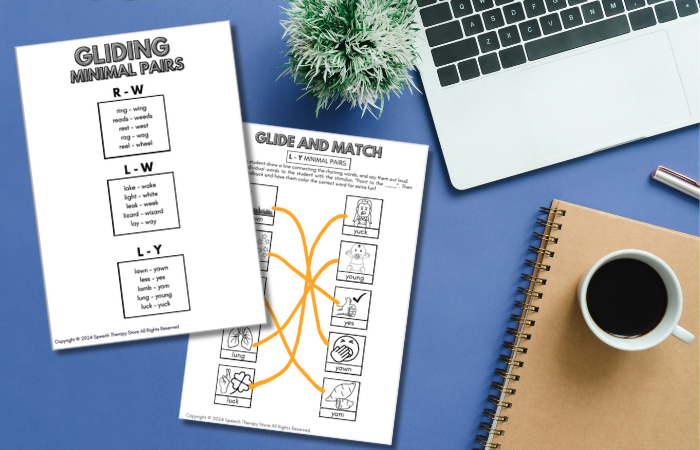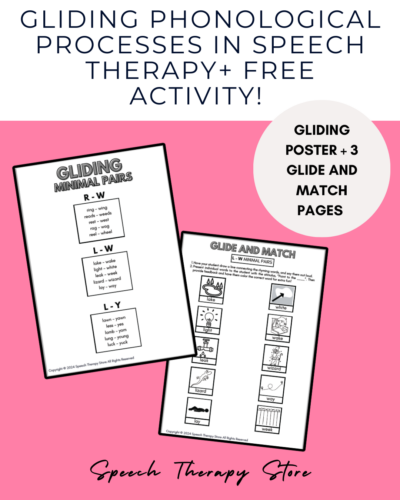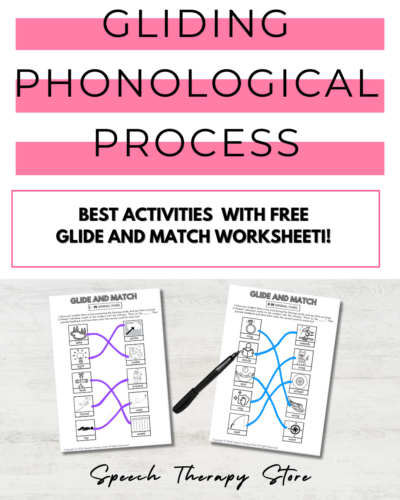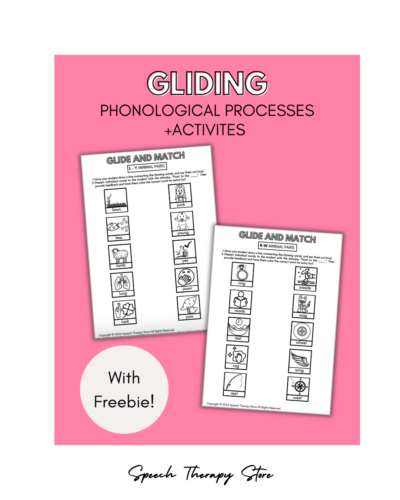Gliding Phonological Process: Unveiling Speech Development in Children
Gliding phonological process is a specific pattern where children replace certain sounds with a glide sound, typically substituting ‘r’ and ‘l’ sounds with ‘w’ and ‘y’.
This process is a normal part of language development in young children, but if it continues past a certain age, it may signify a phonological disorder.
Recognizing and understanding this pattern is crucial for speech-language pathologists (SLPs) and educators as they support children in achieving correct speech articulation.
When addressing gliding, speech-language pathologists employ a range of strategies, from engaging educational materials to innovative technology, to facilitate the correct pronunciation of sounds.
In this post, we will cover what gliding is in relation to other phonological disorders, how to identify them, the best therapeutic techniques to use for gliding in speech therapy, assessing phonological processes, as well as provide a freebie for you to start practicing gliding with your caseload today!
Key Takeaways
- Gliding phonological process is normal in early language development but can indicate a disorder if persistent.
- SLPs utilize personalized therapy techniques to correct gliding in children.
- Continuous collaboration and adaptation of strategies are essential for effective phonological process treatment.

Understanding Phonological Processes
Phonological processes are vital in the development of speech and language skills.
Definition and Overview
Phonological processes are patterns of sound errors that young children use to simplify speech as they are learning to talk. A phonological disorder occurs when these processes persist beyond the typical age of development. Phonological processes can include patterns like substituting all sounds made in the back of the mouth, like “k” and “g”, for those made in the front of the mouth like “t” and “d”.
Importance for Language Skills
Mastering speech sounds through the elimination of phonological processes is a key milestone in language development. It ensures clear communication and prevents potential misunderstandings. Consistent patterns of errors can be an indicator of phonological disorders, which may require intervention to correct.
Roles of Speech-Language Pathologists
Speech-Language Pathologists (SLPs) are crucial in diagnosing and treating phonological disorders. They assess children’s speech patterns, identify persisting phonological processes, and create tailored intervention plans. Our role in supporting language development is to provide targeted strategies that facilitate the accurate production of speech sounds.
Common Phonological Processes
Phonological processes are patterns of sound errors that young children use when learning to speak. We often see these processes diminish as linguistic proficiency grows, yet they are critical in understanding speech development.
Check out The Best Handout for Phonological Processes for a quick overview of the most common phonological processes!

Gliding
Gliding occurs when liquid consonants like /l/ and /r/ are replaced by glides such as /w/ and /y/. For instance, the word “rabbit” may be pronounced as “wabbit”.
This process typically diminishes by the age of five.
- Gliding Minimal Pair Example:
- Leaf /lif/ → Yeaf /yif/
- Red /rɛd/ → Wed /wɛd/
Final Consonant Deletion
Final consonant deletion is the omission of the final consonant in a word. For example, “cat” becomes “ca.” This process simplifies the syllable structure and is more common in children up to the age of three and a half.
- Final Consonant Deletion Example:
- Bed /bɛd/ → Be /bɛ/
FOR YOU! A few weeks ago we published a highly rated blog on Final Consonant Deletion. Check it out and grab our Final Consonant Deletion Interactive Freebie!
Consonant Cluster Reduction
When a consonant cluster, which is a group of consonants uttered without an intervening vowel, is simplified into a single consonant, it’s known as consonant cluster reduction. The word “spoon” might be spoken as “poon”.
- Consonant Clusters Example:
- Stop /stɒp/ → Top /tɒp/
PRO TIP! We have a growing library of Articulation Posts with interactive freebies to address initial and final articulation. These are a great resource to use to address consonant cluster reduction, whether it is the front sound or a sound at the end of a word.
Weak Syllable Deletion
Weak syllable deletion is the process where unstressed (or weak) syllables/group of sounds are omitted from multi-syllable words. “Banana” becomes “nana,” typically occurring in children up to four years of age.
- Weak Syllable Deletion Example:
- Telephone /ˈtɛlɪfoʊn/ → Tephone /ˈtɛfoʊn/
FOR YOU! Using multiple meaning words is a great way to work on weak syllable deletion. Be sure to check out our 430+ free multisyllabic word list activity bundle.
Velar and Palatal Sounds
Velar fronting and palatal substitution involve alterations in the articulation of velar and palatal sounds. Velar consonants like /k/ and /g/ are replaced with consonants produced more anteriorly in the mouth (e.g., /t/ and /d/). Palatal sounds, such as /ʃ/, may replace other consonants.
- Velar and Palatal Sounds Examples:
- Key /ki/ → Tee /ti/ (Velar Fronting)
- Shoe /ʃu/ → Sue /su/ (Palatal Substitution)
This blog post covers Fronting Phonological Processes in depth and also includes a free Fronting download to use in your speech therapy sessions today!

Phonological Disorders in Children
Phonological process disorders are a type of speech sound disorder that can affect young children, often becoming apparent in the early years of their speech development. Typically, these disorders are identified when a child’s speech does not follow the expected patterns of articulation and sound use according to their age.
Identification
We recognize the critical role of early identification in addressing a phonological error. If a child consistently replaces one sound with another, a phonological pattern that persists past the expected age, they may be presenting a phonological process like gliding.
Early signs to monitor include:
- Substitution of sounds: For instance, replacing /r/ with /w/ (saying “wabbit” instead of “rabbit”).
- Omission of sounds: Children may omit sounds in words (saying “boo” for “blue”).
- Simplification of word structures: A child may simplify complex word structures, which is beyond what is typical for their developmental level.
Children typically outgrow these processes by the age of five. If these patterns persist, it suggests the need for a more in-depth evaluation.
Speech-Language Pathology Intervention
We utilize speech-language pathology intervention to assist in the remediation of a phonological process disorder. Speech Pathologists treatment of speech sound disorders are tailored to the child’s unique needs and focus on improving speech sound production. Key components of intervention include:
- Targeting specific phonological processes: Therapy aims at correcting specific patterns, such as gliding, that the child is using inappropriately for their age.
- Enhancing phonological awareness: We enhance the child’s ability to recognize and manipulate sounds in language, which is crucial for speech and literacy development.
- Customizing treatment plans: Using age-appropriate activities and materials for engaging the child and promoting effective learning.
Regular sessions and continuous monitoring of progress are essential to navigate the complexities of phonological disorders in young children and help steer their speech development back on course.

Assessing Phonological Process Disorders
In evaluating phonological process disorders, we focus on identifying patterns of speech errors that affect intelligibility.
Our assessment hinges on discerning whether the substitution of a glide for a liquid or for another consonant – particularly at the beginning of words in the initial sound position – is developmental or indicative of a disorder.
Diagnostic Tools
Assessment Batteries: We utilize a variety of standardized tests designed to evaluate a child’s speech development. Our chosen tests typically include components that specifically analyze the occurrence of phonological processes.
- Age Norms: Reference tables that indicate typical ages by which children have outgrown certain phonological processes.
- Recording Sheets: Structured forms where we document speech sounds in various word positions, noting whether sound substitutions, like a glide for a stop sound, occur.
Speech Samples: We collect spontaneous speech samples to analyze the child’s production of speech sounds in different contexts. Here, we’re vigilant about the initial sound position at the beginning of words, as it holds significant diagnostic value.
- Contextual Analysis: Deliberate selection of words that may elicit the targeted phonological processes.
- Phonetic Inventory: A list that highlights which sounds the child produces correctly and incorrectly.
Observational Reports: We may also gather anecdotal evidence from parents and teachers regarding the child’s speech in various settings.
Interpreting Assessment Results
We take special care when interpreting the data from our assessments. For example, if a child substitutes a voiceless sound, such as “w” for “r” (as in “wabbit” for “rabbit”), especially in the initial position, we explore whether this is part of typical speech development or suggests the presence of a disorder.
- Phonological Patterns: We meticulously categorize identified patterns and compare them against developmental norms to determine if intervention is required.
- Severity Scales: Applying severity scales helps us gauge the impact of the disorder on the child’s intelligibility and communication effectiveness.
Guidelines for Parents and Educators: We ensure to include clear tips for non-professionals, emphasizing the importance of early detection and the benefits of professional intervention. A printing tip for documents we provide is to ensure they are printed with the key assessment results at the top of each page for easy reference.
SEE ALSO: 430+ Free Multisyllabic Words List Activity Bundle

Phonological Processes and Articulation Across Ages
In our exploration of phonological processes, it’s essential to understand how they change with age. We will examine the progression from early to later childhood and how this impacts the acquisition and refinement of language skills.
Early Childhood
During the early years, young children often simplify complex words through phonological processes, one of these being the gliding process. This is when liquids like ‘l’ and ‘r’ are replaced by glides like ‘w’ and ‘y.’ For instance, “rabbit” may be pronounced as “wabbit.” It’s during this phase that language skills are rapidly developed, and a child’s speech is characterized by a high degree of phonological processes.
- Common Gliding Examples:
- /l/ ⟶ /w/ : light ⟶ wight
- /r/ ⟶ /w/ : red ⟶ wed
Children typically outgrow these processes as they receive feedback from their environment and refine their articulation skills.
Later Childhood and Beyond
As children grow older, most phonological processes cease, and their speech patterns closely resemble adult speech. Around the age of five to seven years, we expect them to have mastered the pronunciation of ‘l’ and ‘r’ sounds more consistently. Their language skills become more sophisticated, and articulation errors become less frequent.
- Progression Indicators:
- Consistency in accurate sound production
- Ability to self-correct when occasional errors occur
In the absence of any underlying disorders, children will have typically developed clear articulation patterns by this age, indicative of their maturing language skills.

Implementing Phonological Process Therapy
In implementing phonological process therapy, our focus remains on producing long-term, intelligible speech through strategic, targeted interventions.
Setting Therapy Goals
When setting therapy goals, we first assess which phonological processes to address. For example, in gliding, individuals may substitute /w/* for /r/* and /l/* sounds. We would aim to eliminate this process by a specific age, which varies depending on the child’s developmental level. Goals might include mastering final sounds in words and correctly articulating single consonant sounds in the final position of words.
Customizing Treatment Strategies
We tailor treatment strategies to each individual’s needs. For instance, final sound accuracy can be improved with minimal pair exercises that contrast the correct consonant sound with the child’s typical substitution.
To address L articulation sounds, we may use:
- Visual cues: Showing how to position the tongue
- Tactile feedback: Having the child feel the placement of the tongue
- Auditory discrimination: Recognizing the difference between r vs. l pronunciation
Monitoring Progress
We continuously monitor progress through:
- Data Tracking: Record correct vs. incorrect production of the correct sound in different positions (initial, medial, final).
- Regular assessments: Periodically reassessing to ensure goals are being met and updating the therapy plan accordingly.
Progress monitoring helps us adjust therapy objectives and techniques as necessary to ensure effective intervention.
Activities for Improving Phonological Awareness
We champion a variety of activities to enhance a child’s phonological awareness. These include:
- Sorting Games: Establish categories for sounds that may be glided (like “l” and “r” sounds) versus their correct production.
- 2022 Winter Games 28 Syllable Sort Cards. Phonological Awareness. FREE! by Whitney’s Little Growers is a fun set of sorting cards to teach phonological awareness.
- Sound Matching: Encouraging the child to match sounds to pictures or objects, focusing on the initial sounds that are often omitted.
- Phonological Awareness Initial Sound Matching activity by Kimberly Copeland is a great interactive activity that prompts students to listen to a sound then find the matching item that starts with that sound. This is great for initial consonant deletion.
- Rhyming Exercises: Enhancing the ability to identify and produce rhyming words, thus improving their overall awareness of sound similarities.
- Ice Cream Rhyming Words Worksheets | Phonological Awareness Cut and Sort Sheets by Natalie Lynn Kindergarten is a highly rated cut and paste activity to practice rhyming and phonological awareness.
- Clapping Out Syllables: Helping to identify syllable patterns and the presence of each syllable, thus mitigating syllable deletion.
- Phonological Awareness Syllable Worksheets Cut and Sort Free Back to School by Deborah Marines Teach Magically is a print and go activity that prompts students to cut and paste and then follow the prompt to clap out sounds. This is highly rated and also practices fine motor skills, as well as highlights the vowel sound.
With consistency and practice, these activities aim to cultivate an acute awareness of sound patterns and proper articulation in children navigating through phonological processes.

Therapeutic Techniques for Phonological Disorders
When addressing phonological disorders such as gliding, we focus on techniques aimed at improving the clarity of speech through targeted interventions.
The following subsections will discuss effective approaches that have been shown to assist individuals in overcoming these speech challenges.
Articulation Approaches
We employ articulation approaches to directly work on the physical production of sounds. With gliding, for instance, our target sounds are typically /l/ and /r/.
We practice these sounds in isolation, in syllables, and eventually in complex words and sentences. This graduated approach helps improve the precision of speech.
We may use visual arts techniques, such as drawing or using visual imagery, to reinforce the placement and movement of the tongue.
- Initial Sounds: Begin with the target sound in isolation
For /l/: Lightly tap the tip of the tongue to the alveolar ridge.
- Syllable Level: Combine the target sound with vowels
For /l/: Combine “la, le, li, lo, lu”
Here are some articulation resources for Gliding!
- FREE L Articulation Sounds, Gliding Pronunciation, Speech Language Therapy by Shine Speech Therapy are no prep print and interactive l articulation short stories that practice L in initial, medial and final position to improve pronunciation and gliding.
- Minimal Pairs Smash Mats for Articulation & Phonology FREEBIE by Jill Shook SLP is a smash mat for gliding articulation that is highly rated!
- Bug Articulation Freebie by The Speech Attic is a set of 15 cards that address a variety of phonological processes. Students articulate the target sound as they gather bugs into a jar.
Minimal Pairs Methodology
In the Minimal Pairs Methodology, we present pairs of words that differ by only one phoneme, highlighting the contrast between the correct sound and the error sound.
Our target words could include, for example, “ride” and “wide” to correct gliding of /r/ to /w/. By repeatedly practicing these pairs, the individual can become more aware of the sound distinction and work to correct it.
In our speech sessions, minimal pairs has always been an effective strategy, so we created a freebie for addressing gliding with minimal pairs just for you! Simply scroll to the bottom of this post and check it out!
- Minimal Pair Example:
- “lake” vs. “wake”
Auditory Bombardment
Auditory bombardment is a strategy where we introduce the client to a large number of correct productions of the target sounds.
We read lists of words or sentences that contain the target sound, and this exposes the client to the proper use of the sound in varied contexts.
This reinforces their auditory memory for the sound and supports their own accurate production.
- Sample Word List for /r/:
- rabbit, red, race, rose, read
Here are some of our favorite auditory bombardment resources!
- Minimal Pairs & More: Gliding | Speech Therapy | Phonological Disorders | Cycles by The Pedi Speechie is a great set of print and go minimal pairs flashcards to practice everyday speech patterns with a high frequency.
- Speech Sound Packet for Therapy OR Home Practice: Gliding /R/ by Smarter Speech SLP is a packet that focuses on the r sound for gliding. The r sound is a target that is heard multiple times.
Interactive and Visual Aids
We extensively use interactive and visual aids such as an interactive whiteboard during speech therapy sessions. These tools capture attention and provide a multisensory experience for learning.
For example, to target gliding, we create engaging activities that might include dragging and dropping sounds, or virtual tracing of the mouth movements needed for a sound.
- Interactive Tool: Using an interactive whiteboard to trace the mouth shape for /l/ and /r/.
- Visual Support: Creating visual cues for tongue and lip placement relating to the target sounds.
Here are some great interactive resources for addressing gliding!
- Free l/y Gliding Minimal Pairs Hide & Seek Speech – Spring Theme Boom Card™ PPT by Little Speech Shop is a highly rated interactive boom card set for L/Y gliding.
- Gliding – visual support and activities (FREE) by Free Speech Support is a greta visual that you can print or use digitally to remind students of what gliding is and how to address it. This is a free sample from am articulation and speech sounds visual bundle.
SEE ALSO: Best Handout for Phonological Processing Disorder Therapy

The Role of Educational Material
In addressing gliding phonological processes, we recognize the importance of specifically designed educational materials. These resources not only aid in therapy but also enable consistent practice and reinforcement.
Resources for Therapists and Educators
We often utilize phonological disorder packet targets and minimal pairs bundles to provide structured therapy sessions.
These resources, often created by knowledgeable TPT sellers, serve as foundational tools in our speech-language pathology practices.
For example, a minimal pairs bundle may include word lists contrasting /r/ and /w/ sounds, aiding in auditory discrimination activities.
- Types of Resources:
- Therapy guides
- Minimally contrasted word lists
- Visual aids and flashcards
Additionally, well-structured R W L Y sentences can be pivotal in progressing beyond individual sounds to more complex and conversational utterances.
Independent and Group Activities
For independent work, we’ve found that structured activities like worksheets or games targeting specific sound substitutions enable learners to practice. It’s essential that these materials are engaging and appropriately challenging to encourage regular practice.
- Activity Examples:
- Matching games (for auditory discrimination)
- Fill-in-the-blank sentences
- Sound sorting activities
During group activities, peers can help in modeling correct pronunciation, which can be beneficial for practicing speech sounds within a more naturalistic setting. Group settings are also excellent for professional activities, such as role-playing exercises or group discussions, which can build both confidence and skill.
Here are a few activities that would be great to do in groups!
- FREE Gliding Minimal Pairs R activity Boom Card Tongue Twister r w l y Sentences by Iowa SLP is a high rated boomcard activity that builds tongue twisters while focusing on gliding. These kind of resource types are great to do in a group to build engagement!
- Minimal Pairs Home Practice Game Boards – Gliding R and L by Molly SLP is a fun and engaging game board for small groups to play that address the following phonological processes of gliding.
- FREE Speech-Language Pathology Gliding Candyland Cards by Free SLP Website is a set of domino style cards for students to build together as they address the phonological process of gliding.
SEE ALSO: Stopping Phonological Process: What is it? [Free Worksheets]
Conclusion
We hope that this post is a great resource to understand gliding and phonological processes better and that you found some great resources to use! Grab our Glide and Match Freebie below!
FILL OUT THE FORM BELOW TO DOWNLOAD OUR GLIDING PHONOLOGICAL PROCESS FREEBIE!
Frequently Asked Questions
Phonological processes are patterns of sound errors that children use to simplify speech as they are learning to talk. Gliding is one of these common patterns where liquid sounds like “l” and “r” are replaced with glide sounds like “w” and “y”. We’ll answer the most frequently asked questions regarding gliding in speech.
What are common phonological processes in childhood speech development?
In childhood speech development, besides gliding, we often observe processes such as final consonant deletion, where the last consonant of a word is left off. Additionally, cluster reduction, where a consonant cluster is simplified, and fronting, where back sounds are replaced with front sounds are common.
How is gliding addressed during speech therapy sessions?
During therapy sessions, we address gliding by encouraging the child to practice the correct production of liquid sounds in different contexts, initially in isolation, then in syllables, words, and eventually in conversation. We use engaging activities and give frequent, specific feedback to help the child improve.
At what age should children typically outgrow the gliding phonological process?
Most children outgrow the gliding phonological process by the age of five. If gliding persists beyond this age, it may be advisable to seek a speech-language pathologist’s assessment to provide targeted strategies for correction.
What distinguishes the gliding of fricatives from other speech processes?
Gliding of fricatives is characterized by the replacement of fricatives, such as “s” or “z”, with glide sounds. It is less common and not a typical developmental phonological process like the gliding of liquids. It may often signal the need for a more in-depth speech evaluation.
Can you provide practical exercises to help correct gliding in speech?
To correct gliding, we suggest exercises like minimal pairs that focus on “l” and “r” sounds, singing songs with a high frequency of liquids, and practicing ‘l’ and ‘r’ in different positions of words while engaging in playful activities. Consistent practice is key to improvement.
How do gliding phonological processes manifest differently in adults compared to children?
In adults, gliding is often not developmental but rather a result of a speech disorder, accent, or habit. Adults with gliding may benefit from articulation therapy, and they require a different approach than children since they have already established their speech patterns.
Want Even More Activities for Speech Therapy?
- Free SLP Planner [Updated Yearly]
- 917+ Best Free Boom Cards for Speech Therapy
- 31 Best Wordless Videos to Teach Problem Solving
- 133+ Categories List for Speech Therapy
- The Best Handout for Phonological Processing Disorder Therapy
Want the Best of the Bests?
Be sure to check out our most popular posts below!
- 21 Best Reinforcement Games for Speech Therapy / Teletherapy
- Best IEP Resources
- 71+ Free Social Problem-Solving Scenarios
- 430+ Free Multisyllabic Words List Activity Bundle
- 432+ Free Measurable IEP Goals and Objectives Bank
- 279+ Free Speech Therapy Digital Materials
- 179+ Free Speech Therapy Wh-Questions Printable
